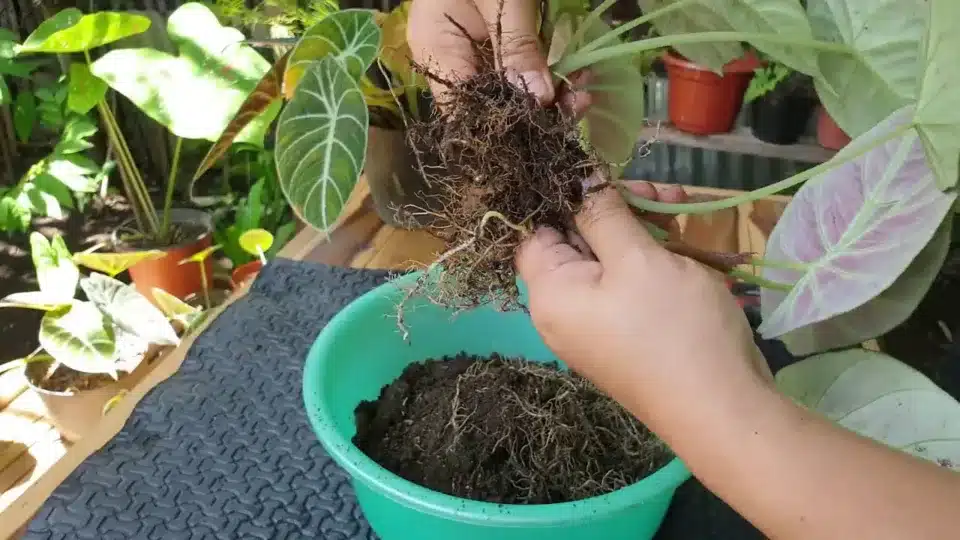Propagating the Alocasia Black Velvet, also known as Alocasia Reginula or the Little Queen, can be a rewarding endeavor, allowing you to expand your collection of these captivating plants.

There are several methods you can explore to propagate your Alocasia Black Velvet, each with its own benefits and considerations. Let’s delve into the various propagation methods for this stunning plant:
1. Offset Propagation:
One of the simplest and most dependable techniques for propagating Alocasia Black Velvet is offset propagation. Offsets are small shoots or baby plants that develop at the base of the main plant. Here’s how to propagate using offsets:
Steps:
- Carefully inspect the base of the Alocasia Black Velvet plant for any offsets that have developed. These are often found near the rhizome.
- Gently separate the offset from the main plant using clean and sterilized scissors or a sharp knife. Ensure that the offset has its own set of roots or growth nodes.
- Plant the offset in a small pot with a well-draining soil mix like perlite, orchid bark, and coco coir.
- Water the offset lightly to settle the soil around the roots, and place the pot in a location with bright, indirect light.
- Keep the soil moist but not soggy as the branch establishes itself and continues to grow.
- Once the offset has developed a strong root system and new growth, you can treat it as a mature Alocasia Black Velvet plant, following the care guidelines mentioned earlier.
2. Division Propagation:
Division propagation involves separating the main plant into smaller sections, each with its own growth points. This method is more complicated than offset propagation, but it can produce numerous young plants from a single adult plant.
Steps:
- Carefully remove the Alocasia Black Velvet plant from its pot, gently shaking off excess soil to expose the rhizome and its divisions.
- Examine the rhizome to identify sections that have their own growth points or plantlets. Each division should have at least one growth point and a few healthy roots.
- Using a clean and sterilized tool, such as a sharp knife or scissors, carefully divide the rhizome into separate sections, ensuring that each section has a portion of the main rhizome and its own plantlet.
- Plant each divided section in its own small pot filled with a well-draining soil mix.
- Water the newly planted divisions lightly, and place them in a location with bright, indirect light.
- Maintain a consistent level of humidity around the divisions to support their growth.
- As the divisions establish themselves and show new growth, continue caring for them according to the Alocasia Black Velvet care guidelines.
3. Seed Propagation:
Seed propagation is another method for growing Alocasia Black Velvet plants, but it requires more patience and attention to detail. This method is often slower and less reliable than offset or division propagation.
Steps:
- Obtain seeds from a reliable source or collect seeds from a mature Alocasia Black Velvet plant.
- If the seeds are from a mature plant, remove them from the berry and soak them in distilled water overnight to enhance germination.
- Plant the seeds in small seedling pots filled with a well-draining soil mix. Sow the seeds at a shallow depth, covering them with a thin layer of soil.
- Place the pots in a warm and humid environment with bright, indirect light.
- Mist the soil on a frequent basis to keep it moist, but avoid overwatering, since this can lead to fungal problems.
- Be patient, as seed germination can take several weeks or even months. When the seedlings have a few true leaves, move them into larger pots with an appropriate growing media.
- Care for the seedlings according to the Alocasia Black Velvet care guidelines, gradually acclimating them to standard care conditions.
Conclusion:
Whether you choose to propagate your Alocasia Black Velvet through offsets, division, or seeds, each method offers its own unique experience and challenges. Offset and division propagation are generally more reliable and efficient methods, while seed propagation requires more time and attention. Regardless of the method you choose, observing the growth and development of new Alocasia Black Velvet plants can be a gratifying journey, allowing you to appreciate the beauty and resilience of these captivating botanical wonders.
Q1. How can I propagate my Alocasia Black Velvet?
You can propagate Alocasia Black Velvet through offsets, division, or seeds. Offsets are the easiest method, while division and seed propagation require more care and attention.
Q2. When is the best time to propagate using offsets?
Offsets can be separated and planted in their own pots when they have their own roots and growth points. Spring is a favorable time for this method.
Q3. What should I consider when propagating through seeds?
Seed propagation is slower and less reliable. Soak seeds overnight before planting them in a well-draining mix. Maintain warmth, humidity, and patience, as germination can take weeks to months.
